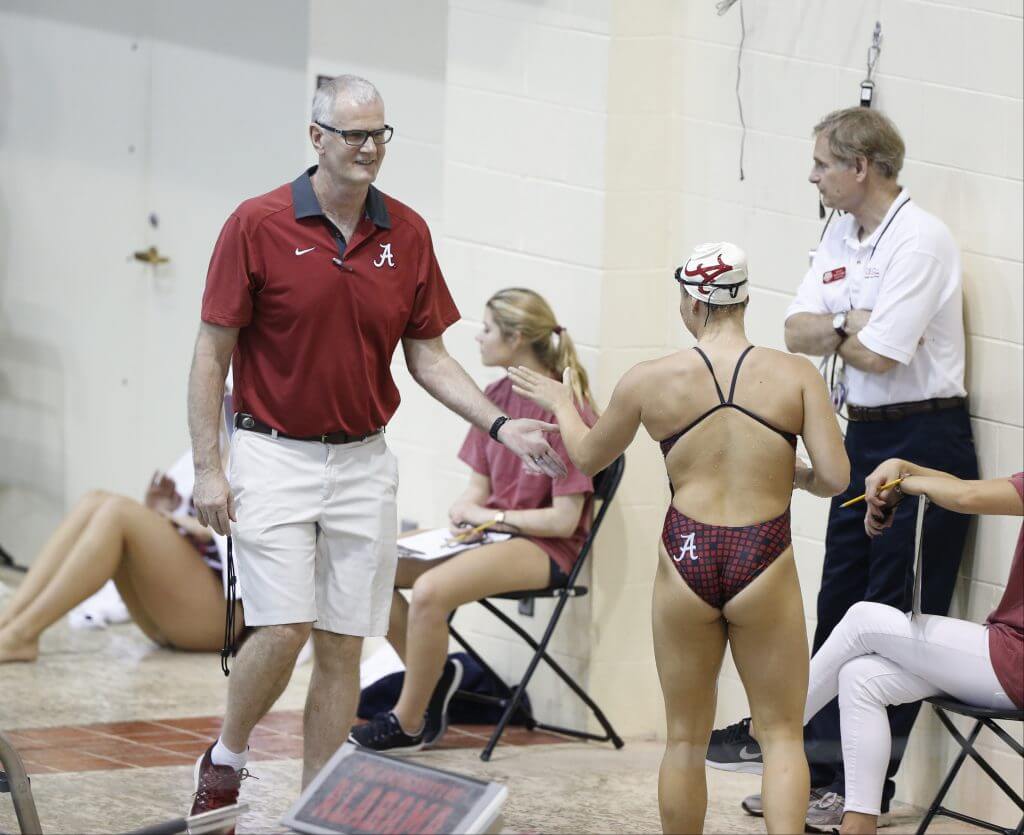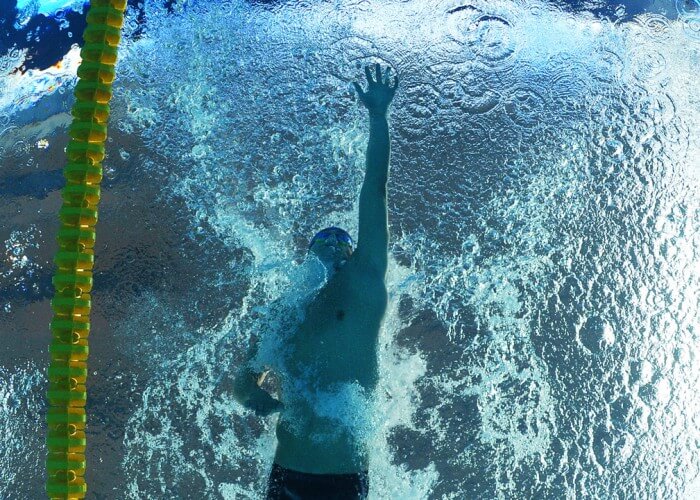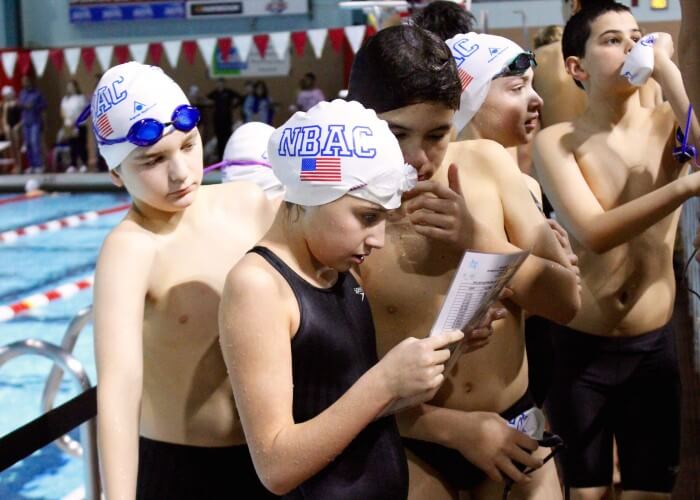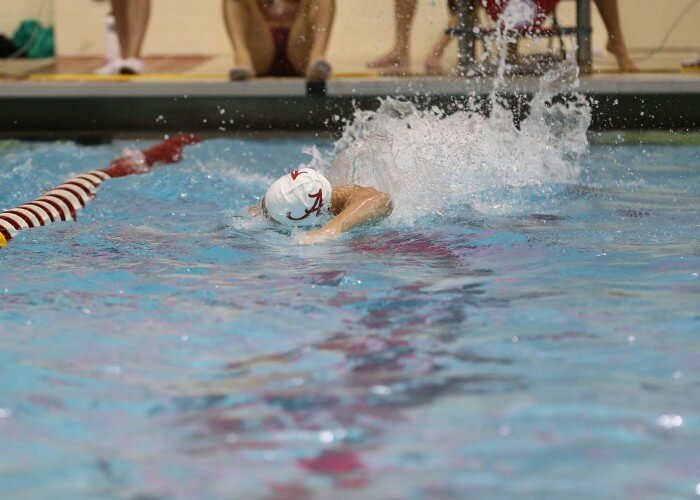The Art of Connected Swimming: Jonty Skinner and Kristian Gkolomeev

By Temarie Tomley, Swimming World College Intern
I didn’t understand the idea of connection until I started swimming in college. Swimming connected means having connection between your arms and legs, through the core, to work in a balanced and unison manner in order vault oneself forward in the water with the greatest efficiency and power.
When I came to the University of Alabama and began swimming under Jonty Skinner, he helped me understand this concept. Jonty is a former world record holder and NCAA champion who has been coaching for over 30 years. Throughout his world-renowned coaching career he has been very technical and detail-oriented. The past 10 to 15 years he has been studying the brain and has been reading up on research and experimenting with new techniques with elite level athletes.
Complexities of Connection

Photo Courtesy: R-Sport / MIA Rossiya Segodnya
One of the technique basics he believes is key to swimming is the idea of connection. One of the first things he told me when I started collegiate swimming was that I was swimming wrong. I was definitely confused when he told me. For example, having a connected freestyle is having your right arm leveraging at the same time the right leg is kicking all put together within a six beat kick. A six beat kick is the most balanced and efficient kick, where the right side will be on the first beat kick and the left side on the fourth beat kick.
Jonty estimates that around half of all swimmers swim incorrectly and that’s based off the swimmers that have come through his program. At first, I couldn’t wrap my mind around it. It was a concept that frustrated me every single day. It took me two years of working on it to fully understand my freestyle stroke and learn how to swim correctly. My time drops are evidence of connectivity’s effectiveness.
Connection of the body in the water really is an art that requires body awareness, feel of the water, and the re-wiring of the brain. Jonty loves talking swimming, so I was able to chat with him after practice about it:
“It (connection) is essential for everything you do. Connection is crucial to every stroke, no matter the distance. It helps with the efficiency of each stroke and helps keep a swimmer balanced in the water. The hardest part is that the brain is wired for the hands and feet. Usually the two do not work in unison in the water, each trying to pull or propel you forward any way they can. The solution is to rewire the brain to focus on the core. Connection is about the core and driving everything through the body and not through the hands. The core is the torso of the body that should manage everything done in the water. It is the piece that unites your arms with your legs in coordinated strokes.”
Balance in the water is the biggest problem that stroke connection helps. It is not difficult for swimmers to lose balance in the water. When this happens the stroke is disrupted and it’s easy to see when it occurs because something called a closed joint position occurs with your feet– it’s an automatic response similar to when you trip on land.
“For a swimmer whose stroke doesn’t connect, it can take at least a year and up to two years to get it right and some people will never get it right,” Jonty said. “Some people don’t have the level of physical intelligence to actually get it the right way.”
This doesn’t mean that you won’t come close. But being connected is more than just having the legs and arms in union, it’s about performing it all in an effortless and smooth motion. It requires the legs to drive the stroke and the tempo of the arms. As a swimmer who was disconnected and is now able to connect, it has taken me two years and I had to rewire and redo my entire stroke. It took more than just doing the motions in the water though. I had to work on strengthening my core in order to perform it correctly. Even now I feel that I need more muscle to improve what I am doing in the water.
Start Early

Photo Courtesy: Taylor Brien
It is best to start teaching children at a young age how to connect their strokes. Jonty says, “It takes a day to teach a 10-year-old a six beat kick and takes a college student a year.”
A child’s brain takes in new information and performs things easier than an adult’s brain because the brain is more elastic and has more connections at a young age. The key is to start off with a foundation. Jonty believes, “The foundation is learning how to balance and float first, then learning how to kick effectively with posture, line, and balance, and then developing rhythm. Then you can learn how to swim, putting the arms into the foundation.”
Luckily for us older folks, to be the best in this sport, it’s not necessary to be connected. Yes, some of the best athletes, such as Allison Schmitt, are extremely connected. Others, such as Katie Ledecky, aren’t completely connected but still amazing at what they do because they are balanced.
“Great technical swimmers win medals and there are swimmers who come out of the animal lane who win medals,” Jonty said.
No one way is necessarily better than the other, although I believe learning how to connect is an easier way than just tons of yardage and training to get to success. Jonty says, that ultimately, this is a mental sport more than a physical sport. “If you don’t think you are going to win, if you don’t believe in who you are, it doesn’t matter what you do or where you train or who you train with or how you train. If you believe you are bringing it that day, then you’re bringing it that day.”
A Natural Connection

Photo Courtesy: Amelia J. Brackin/Alabama
Jonty has not only seen, but used the idea of connection with various successful swimmers throughout his coaching career. The most recent, Kristian Gkolomeev. Kristian, a NCAA Champion for the University of Alabama swam an 18.0 as the anchor leg of the winning 200 medley relay at the Division I NCAA Championships this year.
He is one of the lucky few that never had to learn the concept of connection, but has just “naturally been able to do it.” Jonty attributes his 18.0 to being connected saying, “you don’t go that fast without being connected.” Kristian attributed his success to his teammates and the excitement he felt in the moment, but said that the connected part of his stroke is key to how he swims.
“I flow pretty good in the water and have a good feel for the water,” Kristian said. To him, swimming is all natural and he remembers that race as “it just happened and felt like a normal race where everything came together within the swim from start to finish.” Kristian is looking towards Rio. His sights are set on the 50 and will continue his training and trusting in Jonty to help him with finishing touches.
Connection has been a crucial part of mine and Kristian’s swimming career along with many other swimmers, but it’s not the only thing that helps win a race. Although the technical side of swimming is important, sometimes it’s the connections outside of the pool, like your teammates standing beside you, who have the biggest influence on your swimming.




It is still (even after 40 years) surreal to read about the great things Jonty Skinner has accomplished in the world of swimming/Olympics, when to me, his greatest moment will be when he entered history with his 49.4 world record in the 100 meter freestyle. It was magical. Simply magical.
Great article! What core exercises would you recommend to help strengthen the core to facilitate being more connected?
Jonty has us do dry land training with a mix of core exercises such as V-ups with a medicine ball, medicine ball twists, and foam roll balance where you lay on your back on a foam roller with your hands and feet off the ground. Any sort of planks are also really good, easy to do, and there is a lot of variability with them.